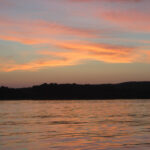Description:
Walloon Lake is located within the Little Traverse Bay Watershed and empties into Lake Michigan through the Bear River. The lake and its watershed are located in Bay, Evangeline, and Melrose townships of Charlevoix County; and Bear Creek and Resort Townships of Emmet County. The lake has a relatively small watershed (22,650 acres) compared to its lake surface area (4,270 acres). Five percent of the Walloon Lake Watershed is classified as wetlands. Of particular importance are the North Arm Wetlands where over 700 acres of land drains through the wetlands before reaching the waters of the North Arm.
Since the turn of the century, Walloon Lake has attracted development. Its irregular shoreline results in a high (3.0) shoreline development factor (i.e., the ratio of shoreline length [27.5 miles] to lake surface area). This means the lake is more susceptible to pollution from shoreline activity (development, erosion, fertilizer use, etc.) than a lake that is rounder. The lake, however, has managed to maintain its excellent water quality despite pressures and impacts from increasing shoreline development. While several features, including the lake’s depth, the presence of marl (a type of soil that contains calcium carbonate and clay), and its small watershed size enhance the lake’s ability to buffer its waters from the detrimental effects of development, the lake is not unaffected. The irregular shoreline of Walloon Lake and its long retention period (4.1 years) make it particularly sensitive to nutrient additions from development.
The majority of pollutants entering the lake are nutrients, primarily phosphorus, and sediment from nonpoint sources, such as runoff from fields and roads, and leachate from failing septic systems. With over 830 dwellings along its shoreline, many aging septic systems are contributing wastewater seepage directly into the lake. In addition, many of the shoreline soils do not adequately remove nutrients from septic system effluent.
Geographic Description:
Walloon Lake is considered an outstanding ecological, aesthetic, and recreational resource. Rolling glacial terrain surrounds its deep waters, including its four distinct depressions or basins:
- Foot – 80′
- Main Basin – 81′
- West Arm – 100′
- North Arm – 52′
Walloon Lake is primarily fed by ground water (53%) and only has a few small inlet creeks, Schoof’s Creek and Fineout. Walloon Lake is characterized as an oligotrophic lake, which includes low plant growth and algae, high water clarity, is generally cold and deep, and is well supplied with oxygen in most areas to support recreational pursuits, including its fine trout fishing. The lake supports populations of walleye, small mouth bass, northern pike, rock bass, perch, and stocked rainbow and lake trout.
Additional Publications:
| Title | Link |
|---|---|
| Comprehensive Water Quality Monitoring (CWQM) | |
| 2020 Walloon Lake Shoreline Survey | |
| 2016 Walloon Lake Shoreline Survey | |
| 2013 Walloon Lake Aquatic Vegetation Survey | |
| 2012 Walloon Lake Wetlands and Tributary Assessment | |
| 2011 Walloon Lake Profile CWQM | |
| 2011 Walloon Lake Greenbelt Survey |



